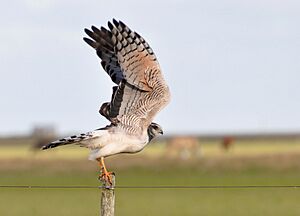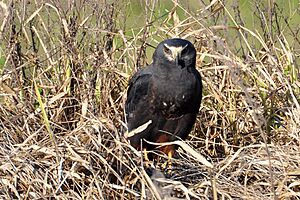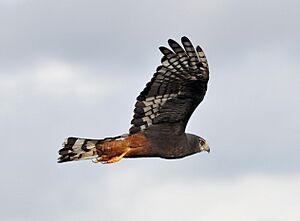Long-winged harrier facts for kids
Quick facts for kids Long-winged harrier |
|
|---|---|
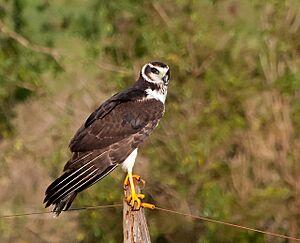 |
|
| Conservation status | |
| Scientific classification | |
| Genus: |
Circus
|
| Species: |
buffoni
|
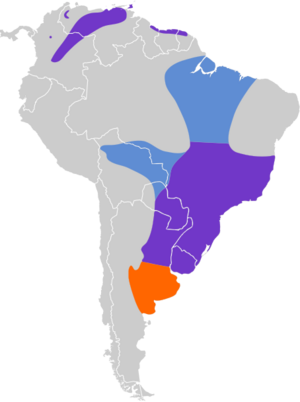 |
|
| Nonbreeding Breeding Year-round | |
The long-winged harrier (Circus buffoni) is a common bird of prey found only in South America. It belongs to the family Accipitridae, which includes eagles, hawks, and other harriers. You can find this bird across most of South America. It lives in grasslands and wetlands.
Long-winged harriers are meat-eaters. They hunt and eat many different animals in their homes. Like owls and other harriers, this bird has a special facial disc. This disc helps them hear very well when they are hunting. The long-winged harrier is not considered endangered. However, its numbers are going down because humans are changing its habitat.
Contents
About the Long-Winged Harrier's Name
The long-winged harrier was first officially described in 1788. A German scientist named Johann Friedrich Gmelin gave it its first scientific name. He put it in the same group as falcons and eagles.
Later, in 1799, a French scientist named Bernard Germain de Lacépède created the group Circus for harrier birds. The name Circus comes from an old Greek word. It means "circle" and refers to how these birds fly in circles. The second part of its name, buffoni, honors a French naturalist named Comte de Buffon. This bird does not have any different types or subspecies.
What Does a Long-Winged Harrier Look Like?
The long-winged harrier is a medium-sized bird of prey. Like most birds of prey, the female harriers are bigger than the males. Males usually weigh about 390 to 464 grams (13.8 to 16.4 ounces). Females are a bit heavier, from 400 to 645 grams (14.1 to 22.8 ounces).
These birds are about 46 to 60 centimeters (18 to 24 inches) long. Their wings can spread wide, from 120 to 155 centimeters (47 to 61 inches). You can spot them by their long, narrow tails and very long wings. Their wings and back are mostly gray. The main feathers on their wings are darker. Other wing feathers have streaks of white, gray, and brown.
Long-winged harriers can look different. Some have a dark color, and some have a light color. Dark birds have a black belly. Females with this dark color might have a brownish belly. Light-colored birds have white undersides. This makes them look very different from the dark ones. Young harriers usually look like the females but have a speckled chest.
This bird looks a lot like its relative, the cinereous harrier. That bird also lives in South America. However, they usually live in different areas.
Like all birds of prey, the long-winged harrier has sharp talons (claws). They use these to catch their food on the ground or in the air. Their legs are a bright orange color. They also have a large, hooked beak. This beak helps them tear apart meat after they catch their prey.
The long-winged harrier is one of the few daytime birds of prey with a facial disc. This disc is made of special feathers around the bird's face. These feathers can stand up when the bird hears sounds. This helps them hear better when hunting. It helps them figure out where sounds are coming from.
We don't know much about the sounds long-winged harriers make. They are not very noisy birds. They usually call when they are flying. Some of their calls sound like a quick "klee-klee-klee." They also make a quieter "thrill" sound that gets lower in pitch.
Where Long-Winged Harriers Live
The long-winged harrier lives all year in most of eastern South America. This includes eastern Argentina, Uruguay, Brazil, and Paraguay. Their home also reaches up to Colombia, Venezuela, and the northern parts of Guyana, Suriname, and French Guiana.
Sometimes, these birds are seen in other places too. This includes Bolivia, Peru, Chile, Trinidad and Tobago, and even far south in Tierra del Fuego. They have also been seen by chance in Panama and the Falkland Islands.
These birds like to live in large grasslands and farm fields. Their hunting style works very well in these open areas. They also live in savannas, marshes, and wetlands across South America.
Long-Winged Harrier Behavior and Life
Food and Hunting
The long-winged harrier is a carnivorous bird, meaning it eats meat. It eats many different animals because it lives in so many places. Its diet includes small mammals like cavies (guinea pigs). It also eats amphibians like frogs and reptiles like lizards. Birds are a big part of their diet, such as crakes and young coots.
They also eat bird eggs. They might take whole nests of water-tyrants. They even raid heronries, which are places where herons nest. Their hunting style is different from other hawks in the same area. Instead of waiting on a high perch, the long-winged harrier flies slowly in big circles. It uses its excellent eyesight and hearing to find its prey.
Reproduction and Life Cycle
Long-winged harriers build their nests on the ground. They usually build them between September and October in grassy areas. Their nests are made from rushes and grass. They are built no more than 3 meters (about 10 feet) off the ground. They are also at least 1 meter (about 3 feet) away from water.
Their breeding season can change depending on where they live. But it usually happens in the summer months, from September to January. During this time, a nest usually holds 3 or 4 eggs per clutch.
Protecting Long-Winged Harriers
Even though the number of long-winged harriers is going down, they are still found in many places. Because of their wide range, the IUCN Red List calls them a species of 'least concern'. This means they are not in immediate danger of disappearing.
Their population is shrinking because their homes are being damaged. This happens especially in wetlands, due to things like drainage, pollution, and other human activities. There are no special conservation plans just for the long-winged harrier right now. However, they do live in many protected areas and conservation sites.



